Introduction of Yoga – Yoga is an ancient practice that originated in India and has been passed down through generations. It is a holistic discipline that combines physical postures (asanas), breath control (pranayama), meditation, and ethical principles to promote overall well-being and spiritual growth.
At its core, yoga seeks to unite the body, mind, and spirit, creating a harmonious balance within oneself and with the surrounding world. The word “yoga” itself comes from the Sanskrit word “yuj,” which means to join or unite.
While yoga is often associated with physical exercise and flexibility, it encompasses much more than just the physical aspect. It is a comprehensive system that addresses the physical, mental, emotional, and spiritual dimensions of a person.
In terms of physical practice, yoga involves performing various postures or asanas, which are designed to strengthen, stretch, and align the body. These postures are typically coordinated with conscious breathing to enhance awareness and focus.
Breath control, or pranayama, is another important aspect of yoga. Through specific breathing techniques, practitioners learn to regulate and control their breath, which can have a profound impact on their physical and mental state.
Meditation is a key component of yoga, allowing individuals to cultivate mindfulness, inner stillness, and deep relaxation. It involves focusing the mind and observing one’s thoughts without judgment, ultimately leading to a state of tranquility and expanded awareness.
Yoga also encompasses ethical principles known as the Yamas and Niyamas, which guide practitioners in living a virtuous and ethical life. These principles include non-violence, truthfulness, contentment, self-discipline, and others.
Overall, yoga is a comprehensive practice that goes beyond the physical aspect of exercise. It is a way of life that promotes self-discovery, self-improvement, and the integration of mind, body, and spirit.
International Day of Yoga – 21 June
Yoga benefits (How yoga good for mind and body?)
Yoga offers a wide range of benefits for both the mind and body.
Here are some of the key advantages:
- Physical Fitness: Regular yoga practice can improve strength, flexibility, and balance. The various asanas (poses) and sequences work on different muscle groups, helping to tone and strengthen the body.
- Stress Reduction: Yoga incorporates breathing exercises, meditation, and mindfulness, which can significantly reduce stress levels. It activates the relaxation response in the body, calming the nervous system and promoting a sense of inner peace and well-being.
- Improved Mental Health: Practicing yoga has been shown to alleviate symptoms of anxiety, depression, and other mental health conditions. It can enhance mood, increase self-awareness, and promote a positive outlook on life.
- Increased Energy and Vitality: Yoga poses, especially inversions and backbends, stimulate blood flow, improve circulation, and boost energy levels. Regular practice can help combat fatigue and increase overall vitality.
- Enhanced Flexibility and Range of Motion: As yoga involves stretching and lengthening the muscles, it can gradually improve flexibility and increase the range of motion in the joints. This can lead to better posture, reduced muscle tension, and decreased risk of injury.
- Better Breathing: Yoga emphasizes deep, mindful breathing techniques that promote proper lung function and enhance respiratory health. It can increase lung capacity, improve oxygen flow, and help manage respiratory conditions such as asthma.
- Improved Focus and Concentration: The combination of physical movement, breath control, and meditation in yoga can sharpen concentration and enhance mental clarity. It trains the mind to stay present and focused, which can improve productivity and cognitive function.
- Better Sleep: Practicing yoga regularly can help regulate the sleep-wake cycle and promote restful sleep. It reduces stress and anxiety, relaxes the body, and prepares the mind for a peaceful night’s rest.
- Increased Mind-Body Awareness: Yoga cultivates a deeper connection between the mind and body. Through mindful movement and breath awareness, practitioners become more attuned to their physical sensations, emotions, and overall well-being.
- Holistic Health: Yoga is not just a physical exercise; it encompasses a holistic approach to health and well-being. It encourages a balanced lifestyle, healthy eating habits, and self-care practices, promoting overall wellness on multiple levels.
It’s important to note that individual experiences may vary, and it’s advisable to consult a healthcare professional before starting any new exercise or wellness program.
Yoga poses (Types of Yoga poses)
There are numerous yoga poses, or asanas, that offer various physical and mental benefits.
Here are some commonly practiced yoga poses:
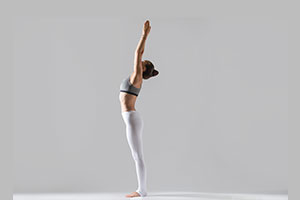
Mountain Pose (Tadasana)
This pose is a foundational standing posture that promotes balance, stability, and proper alignment.
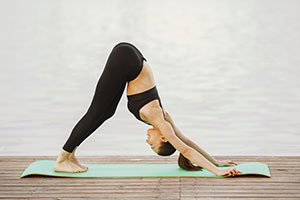
Downward-Facing Dog (AdhoMukhaSvanasana):
This pose stretches the entire body, strengthens the arms and shoulders, and lengthens the spine.
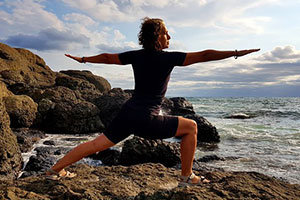
Warrior I (Virabhadrasana I)
This pose builds strength in the legs and core, improves balance, and opens the chest and shoulders.
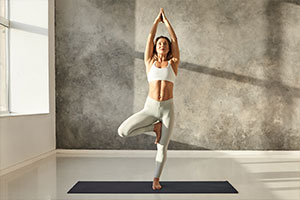
Tree Pose (Vrksasana)
This standing pose improves balance, concentration, and stability while stretching the hips and strengthening the legs.
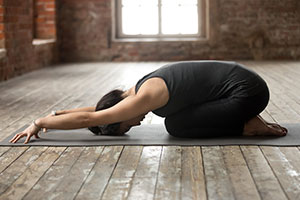
Child's Pose (Balasana)
This gentle resting pose promotes relaxation, releases tension in the back and shoulders, and calms the mind.
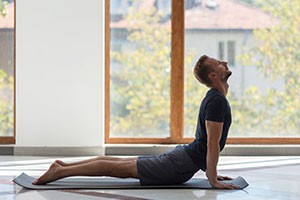
Cobra Pose (Bhujangasana)
This backbend pose strengthens the back muscles, opens the chest, and improves spinal flexibility.

Bridge Pose (SetuBandhasana)
This pose strengthens the back, buttocks, and legs while opening the chest and stretching the hip flexors.

Seated Forward Bend (Paschimottanasana)
This pose stretches the entire back of the body, particularly the hamstrings, and promotes relaxation.

Corpse Pose (Savasana)
This final relaxation pose is done lying down, allowing the body and mind to completely relax and integrate the benefits of the practice.

Lotus Pose (Padmasana)
This seated posture is commonly used for meditation and pranayama. It promotes calmness, groundedness, and stability.
Frequently Asked Questions
There are several types of yoga, including Hatha, Vinyasa, Ashtanga, Bikram, Iyengar, Kundalini, Yin, and Restorative. Each type has its own focus, intensity, and style of practice.
Yes, yoga is a form of exercise that incorporates physical postures, breath control, and mindfulness. It helps improve strength, flexibility, balance, and overall physical fitness.
Yes, yoga is suitable for people of all ages and fitness levels. Modifications can be made to accommodate individual abilities and limitations. However, it’s always advisable to consult with a healthcare professional before starting a new exercise program, including yoga.
No, you don’t need to be flexible to do yoga. In fact, yoga can help improve flexibility over time. Many yoga poses can be modified or adapted to suit different levels of flexibility.
The frequency of yoga practice can vary depending on individual preferences and schedules. Ideally, it is recommended to practice yoga at least 2-3 times per week to experience the benefits. However, even a short daily practice can be beneficial.
While yoga alone may not lead to significant weight loss, it can be a part of a comprehensive weight management program. Yoga promotes mindfulness, self-awareness, and a healthy lifestyle, which can indirectly support weight loss efforts.
Yes, yoga is known for its stress-reducing benefits. The combination of physical movement, breath control, and mindfulness in yoga can activate the relaxation response in the body, helping to reduce stress and anxiety levels.
Yes, prenatal yoga is a modified form of yoga that is safe and beneficial during pregnancy. It helps improve strength, flexibility, and relaxation, and can also help prepare the body for childbirth. It’s important to consult with a prenatal yoga instructor and healthcare provider for guidance.
Yes, yoga can help alleviate back pain by strengthening the core muscles, improving posture, and increasing flexibility. Certain yoga poses specifically target the back and can provide relief from discomfort. However, it’s crucial to practice under the guidance of a qualified instructor and seek professional advice for any underlying medical conditions.
Yoga can often be adapted for individuals with injuries or medical conditions. However, it’s important to consult with a healthcare professional and work with a qualified yoga instructor who can provide modifications and ensure safety during the practice.
Different between Yoga and Exercise (Difference between Yoga & Exercise) / ( How yoga differ from Exercise ?)
Yoga and exercise are both physical activities that contribute to overall health and well-being, but they differ in their approaches, focus, and goals.
Here are some key distinctions between yoga and exercise:
- Approach: Yoga is a holistic practice that integrates physical postures (asanas), breath control (pranayama), meditation, and ethical principles to promote overall well-being. It emphasizes the mind-body connection and seeks to create harmony and balance within oneself. Exercise, on the other hand, primarily focuses on physical exertion and improving fitness levels, often through repetitive movements and targeted muscle training.
- Mindfulness: Yoga places a strong emphasis on mindfulness and being present in the moment. It encourages awareness of breath, sensations, and thoughts during the practice. Exercise, while it can also enhance mindfulness, often focuses more on external goals such as burning calories or achieving specific fitness targets.
- Flexibility vs. Strength: Yoga incorporates a balance of flexibility, strength, and balance in its practice. It includes stretching and lengthening the muscles through various postures. Exercise, on the other hand, tends to focus more on building strength, endurance, and cardiovascular fitness.
- Breath and Energy: Yoga pays particular attention to breath control (pranayama) and energy flow within the body. It uses specific breathing techniques to influence the nervous system and promote relaxation or invigoration. Exercise typically involves breathing naturally, and while breath control can be incorporated in certain forms of exercise (e.g., Pilates, martial arts), it is not a central component in the same way as in yoga.
- Mind-Body Connection: Yoga seeks to cultivate a deeper mind-body connection and awareness. It encourages self-reflection, introspection, and exploration of the inner self. Exercise, while it can have mental benefits, often focuses more on physical performance, strength gains, and external objectives.
- Spiritual Aspect: Yoga has a spiritual heritage and can be practiced as a means of self-realization and personal growth. It encompasses philosophical concepts and ethical principles. Exercise, in most cases, is not rooted in spirituality and primarily focuses on physical fitness and health.
- Adaptability: Yoga can be practiced by people of various fitness levels, ages, and physical conditions. It offers modifications and variations to suit individual needs. Exercise, while it can be adapted, may have more specific requirements and may not always accommodate individuals with certain limitations or health conditions.
Ultimately, the choice between yoga and exercise depends on personal preferences, goals, and what one seeks to achieve. Many people incorporate both yoga and exercise into their routines to enjoy the benefits of both approaches.
Instrument to be used at time of yoga (Yoga accessories)
While yoga typically does not require any specific instruments or equipment, there are a few optional items that can enhance your yoga practice. These items can help provide support, stability, comfort, and aid in deepening your practice.
Here are some common instruments used during yoga:
- Yoga Mat: A yoga mat provides cushioning and grip, ensuring a stable surface for your practice. It helps prevent slipping and offers support for various yoga poses.
- Yoga Blocks: Blocks are typically made of foam, cork, or wood and can be used to modify poses, provide support, or increase accessibility for individuals with limited flexibility. They can be placed under hands, feet, or sit bones to make poses more accessible or to deepen stretches.
- Yoga Strap: A yoga strap is a long, adjustable strap made of cotton or nylon. It assists in stretching, reaching, and maintaining proper alignment. Straps are particularly helpful in poses where reaching certain body parts might be challenging.
- Bolster: A bolster is a firm cushion that provides support and helps maintain proper alignment in restorative and gentle yoga poses. It aids in relaxation and helps release tension.
- Blanket: A yoga blanket can be used for additional padding, support, and warmth during relaxation or restorative poses. It can also be folded or rolled to provide extra cushioning or support under knees, hips, or shoulders.
- Meditation Cushion or Yoga Pillow: These cushions or pillows provide comfort and support during seated meditation or for maintaining a comfortable posture for an extended period.
- Yoga Wheel: A yoga wheel is a circular prop that can help improve flexibility, balance, and strength. It is particularly useful for backbends, inversions, and deepening stretches.
- Eye Pillow: An eye pillow is a small cushion filled with herbs, flaxseed, or other soothing materials. Placing it over your eyes during relaxation poses or meditation can help promote relaxation and reduce eye strain.
Remember, while these instruments can enhance your yoga practice, they are not essential. The most important aspect of yoga is your commitment to the practice itself, focusing on breath, alignment, and mindfulness.
Read this article also: Yoga for Brain Power: Easy Hacks For A Sharper And Smarter Mind
If you don’t like this article/post please share your feedback.





